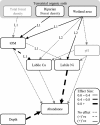Dry conditions disrupt terrestrial-aquatic linkages in northern catchments
- PMID: 27197025
- PMCID: PMC6849552
- DOI: 10.1111/gcb.13361
Dry conditions disrupt terrestrial-aquatic linkages in northern catchments
Abstract
Aquatic ecosystems depend on terrestrial organic matter (tOM) to regulate many functions, such as food web production and water quality, but an increasing frequency and intensity of drought across northern ecosystems is threatening to disrupt this important connection. Dry conditions reduce tOM export and can also oxidize wetland soils and release stored contaminants into stream flow after rainfall. Here, we test whether these disruptions to terrestrial-aquatic linkages occur during mild summer drought and whether this affects biota across 43 littoral zone sites in 11 lakes. We use copper (Cu) and nickel (Ni) as representative contaminants, and measure abundances of Hyalella azteca, a widespread indicator of ecosystem condition and food web production. We found that tOM concentrations were reduced but correlations with organic soils (wetlands and riparian forests) persisted during mild drought and were sufficient to suppress labile Cu concentrations. Wetlands, however, also became a source of labile Ni to littoral zones, which was linked to reduced abundances of the amphipod H. azteca, on average by up to 70 times across the range of observed Ni concentrations. This reveals a duality in the functional linkage of organic soils to aquatic ecosystems whereby they can help buffer the effects of hydrologic disconnection between catchments and lakes but at the cost of biogeochemical changes that release stored contaminants. As evidence of the toxicity of trace contaminant concentrations and their global dispersion grows, sustaining links among forests, organic soils and aquatic ecosystems in a changing climate will become increasingly important.
Keywords: Hyalella azteca; climate change; dissolved organic carbon; drought; littoral invertebrates; metal toxicity; organic soils; terrestrial organic matter.
© 2016 The Authors. Global Change Biology Published by John Wiley & Sons Ltd.
Figures



References
-
- Adkinson A, Watmough SA, Dillon PJ (2008) Drought‐induced metal release from a wetland at Plastic Lake, central Ontario. Canadian Journal of Fisheries and Aquatic Sciences, 65, 834–845.
-
- Agriculture and Agri‐Food Canada (2016) National Agroclimate Information Service Archive Maps. Available at: http://www.agr.gc.ca/DW-GS/historical-historiques.jspx (accessed 16 February 2016).
-
- Arnott SE, Yan N, Keller W, Nicholls K (2001) The influence of drought‐induced acidification on the recovery of plankton in Swan Lake (Canada). Ecological Applications, 11, 747–763.
-
- Bartels P, Cucherousset J, Gudasz C et al (2012) Terrestrial subsidies to lake food webs: an experimental approach. Oecologia, 168, 807–818. - PubMed
-
- Barton DR, Hynes HBN (1976) The distribution of amphipoda and isopoda on the exposed shores of the Great Lakes. Journal of Great Lakes Research, 2, 207–214.
MeSH terms
LinkOut - more resources
Full Text Sources
Other Literature Sources
Research Materials

